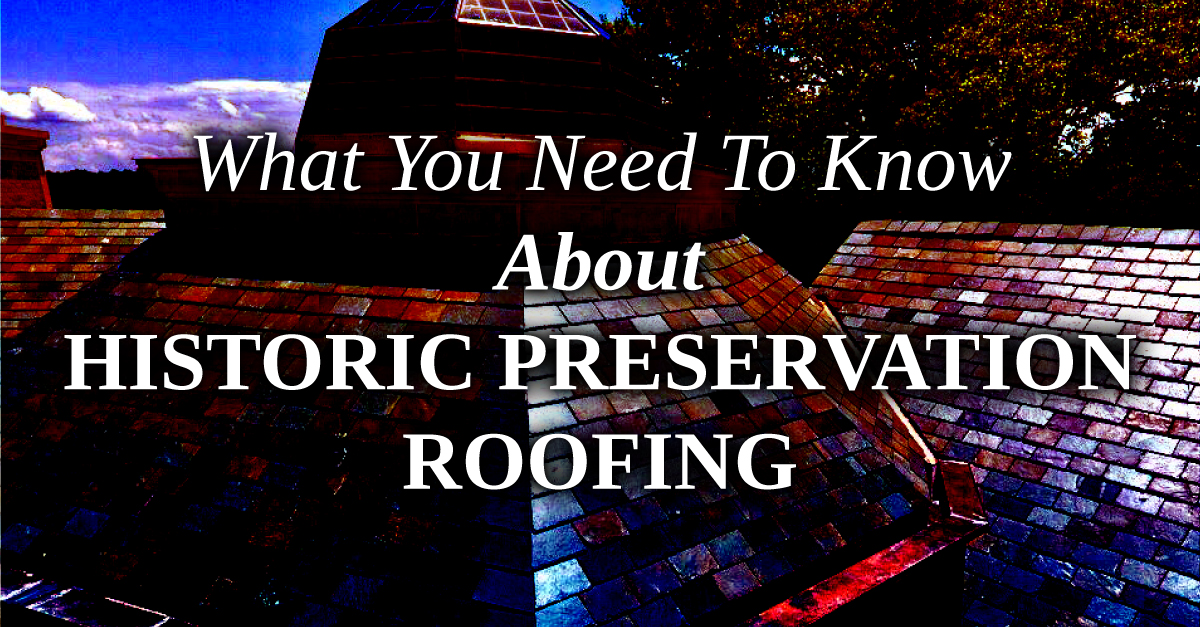What You Need To Know About Historic Preservation Roofing

Replacing any kind of roof is always a huge task. However, when it comes to preserving a roof with historic architecture, you can run into many complications. This is why it’s important to work with a roofing contractor with plenty of experience in preserving historic roofing systems.
One of the unique aspects of the Norfolk, VA area is we have numerous historic buildings. You can find houses dating back 100-200 years. When you have such a home requiring roof repair or replacement, it is essential to learn a thing or two about historic preservation roofing.
What It Means to Preserve a Historic Roof
Preserving a historic roof is not like repairing or replacing any regular roofing system. Historic roofs are generally made with different roofing materials than modern roofs. To preserve the architectural significance of a historic home, you need to use the same materials or modern alternatives which closely resemble them.
Preserving a historic roof also means dealing with unique and complicated roof designs you don’t often find on modern homes. Experts in historic preservation roofing work with extreme attention to detail and employ specialized skills to get the job done right and safely.
Besides, the roofer must do extensive research to uncover the history of your roof, including locating architectural records to learn what the original roof looked like and the kinds of modifications made over the years.
How Long It Takes to Preserve a Historic Roof
The process of restoring a historical roof can be painstaking. It starts with an assessment to determine what is wrong with the roof, such as where the water intrusion is making its entry. Is the old roof experiencing natural wear and tear, or is there an underlying issue which must be fixed before installing a new roofing material?
Overall, there isn’t a one-size-fits-all restoration period when it comes to historic preservation roofing. For an average-sized home, you can expect the process of installing a new roof to take anywhere between 1-3 days under optimal conditions.
More often, historic roofing materials are delicate and may not be walked on, which further prolongs the restoration time. Proper scaffolding and other specialized tools must be used to ensure the roof assessment is non-invasive.
Historic Preservation Roofing Requires Experts
Not every roofing contractor can restore a historic roof. Repairing or replacing historic roofing systems is complicated due to old materials and antiquated installation techniques. A historical roof is not simply an old roof; it is an integral component of the building’s character. To repair or replace a historical roof while maintaining the beauty and historical significance of the building requires an expert with in-depth knowledge of old roofing methods and materials.
Only a handful of roofing contractors in any given area will know and understand historic roof preservation techniques. These contractors have undergone specialized training to handle historic preservation roofing. They also have extensive experience working with historic roofing materials such as slate, clay tile, wood slate/shakes, and metal.
Sourcing the Right Material for Your Historic Roof
Unless your historic home has slate, ceramic tile, or metal roofing, you might not know with certainty what type of shingles were installed on your roof originally. If you are unable to source your original shingle type, consider choosing a simple shingle style.
The least intrusive shingle style is the standard three-tab asphalt shingle. Go for shingles with an unobtrusive color, like black, dark grey, dark brown, or dark reddish-brown. Don’t use bright reds, blues, or greens unless you have proof your home had them originally.
Be careful when choosing an architectural-grade or laminated type of shingle. These shingle styles often have high contrast colors, texture, as well as heavy fake shadow lines with strong diagonal patterns your historical roof never had.
However, clay tile, cedar shingles, metal, and slate roofing materials are still readily available today. Several manufacturers even make substitute concrete tiles which closely resemble traditional clay tiles.
How to Tell if You Need Historic Preservation Roofing
Other than ensuring your home maintains the old architectural design, historic roofing restoration honors the historic character of a building and the people who lived there before. In most cases, historic preservation roofing is associated with historic structures such as churches, museums, libraries, and government buildings.
However, a building doesn’t have to be listed on the National Register of Historic Places to be considered significant. Many private homes can have significant historic value too. You might especially require historic preservation roofing if you live in:
- A home located in a historical district
- A house constructed in the early 20th century or before
- An older home with unusual or unique roof features or materials
In some areas, there are laws and ordinances which govern making improvements to any historic structure, including homes. A big part of historic preservation roofing is ensuring all the rules are followed.
Working with the Right Contractor
If you have a historical home in the Norfolk, VA area, never underestimate the importance of choosing a qualified historic preservation roofing contractor with extensive experience working on historic homes. At Stevens Roofing Corp, we have the skills in restoring and preserving historic roofs which only comes from decades of experience serving our local community. Contact us today to schedule a free inspection of your historic roof!


